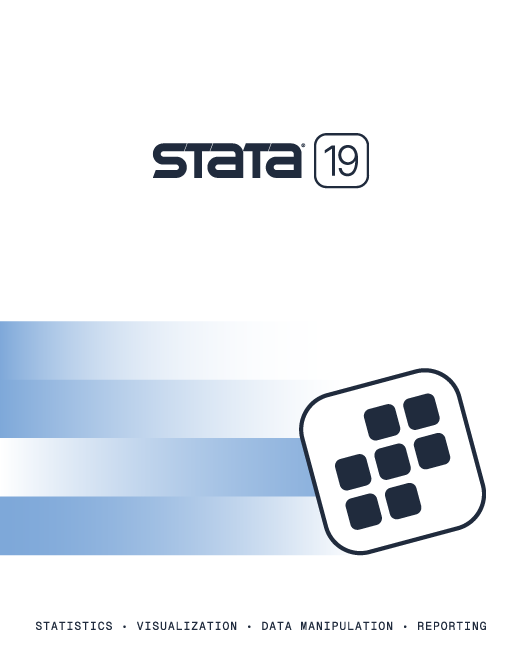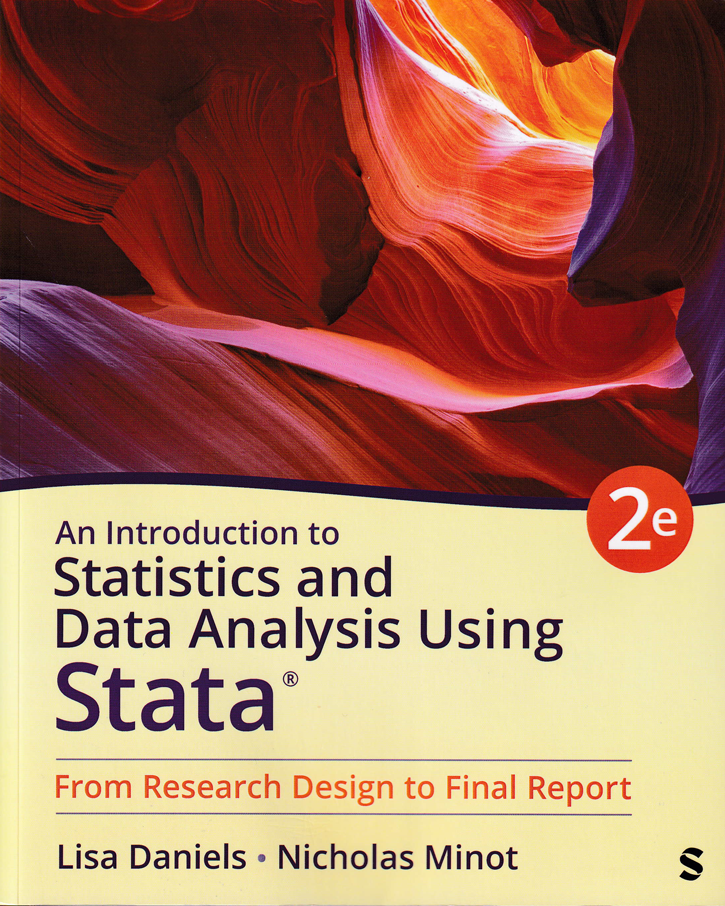

2025 Stata Conference • Nashville, TN • 31 July–01 August
An Introduction to Statistics and Data Analysis Using Stata, Second Edition |
||||||||||||||||||||||||||||||||
 Click to enlarge See the back cover |

As an Amazon Associate, StataCorp earns a small referral credit from
qualifying purchases made from affiliate links on our site.
eBook not available for this title
eBook not available for this title |
|
||||||||||||||||||||||||||||||
Comment from the Stata technical groupAn Introduction to Statistics and Data Analysis Using Stata, by Lisa Daniels and Nicholas Minot, is an excellent textbook for for introducing statistics, research methods, and Stata to undergraduate students in social sciences, behavioral sciences, business, and similar disciplines. This book walks students through the entire research process from designing a study and collecting data to performing statistical analyses and reporting results. The authors discuss descriptive statistics and graphics for describing data; hypothesis testing for one and two means; cross-tabulations; tests for proportions; tests for association; and linear, logistic, and probit regression. The second edition also covers advanced methods in regression analysis, including instrumental variables, time-series analysis, and panel-data regression. The authors devote one of the early chapters to introducing Stata. Then, throughout the book, they demonstrate how to use Stata commands and Stata's point-and-click interface for each data management task, graph, and statistical analysis they discuss. To illustrate real-world applications, the new edition contains updated examples covering current and engaging topics, such as the impact of artificial intelligence on education, the characteristics of individuals using online dating apps, and COVID-19 practices, among many others. Daniels and Minot provide many resources for instructors and students. Instructors have access to suggested test and homework problems along with solutions. They can also take advantage of PowerPoint slides, which correspond with each chapter in the book. Students have access to all datasets so that they can work along with examples in the book. They can also use the provided electronic flash cards to review the concepts discussed in each chapter. Drawing on over 28 years of experience teaching statistics to undergraduate students, the authors are careful to include everything students need for an introductory statistics course taught using Stata. |
||||||||||||||||||||||||||||||||
Table of contentsView table of contents >> Preface
Acknowledgements
Part I The Research Process and Data Collection
Chapter 1 A Brief Overview of the Research Process
1.1 Introduction
1.2 What Is Research 1.3 Steps In The Research Process
1.3.1 Read the Literature and Identify Gaps or Ways to Extend the Literature
1.4 Conclusion 1.3.2 Examine the Theory 1.3.3 Develop your Research Questions and Hypotheses 1.3.4 Identify your Research Method 1.3.5 Examine the Data or Other Evidence 1.3.6 Write the Research Paper Exercises Key Terms Chapter 2 Sampling Techniques
2.1 Introduction
2.2 Sample Design 2.3 Selecting a Sample
2.3.1 Probability and Nonprobability Sampling
2.4 Sampling Weights 2.3.2 Identifying a Sampling Frame 2.3.3 Determining the Sample Size 2.3.4 Sample Selection Methods
2.4.1 Calculating Sampling Weights
Exercises 2.4.2 Using Sampling Weights Key Terms Chapter 3 Questionnaire Design
3.1 Introduction
3.2 Types of Questionnaires
3.2.1 Type of Interview
3.3 Guidelines For Questionnaire Design 3.2.2 Structured and Semi-structured Questionnaires 3.2.3 Types of Questions
3.3.1 General Guidelines
3.4 Recording Responses 3.3.2 Question Order 3.3.3 Phrasing the Questions
3.4.1 Responses in the Form of Continuous Variables
3.5 Skip Patterns 3.4.2 Responses in the Form of Categorical Variables 3.6 Ethical Issues Exercises Key Terms Part II Describing Data
Chapter 4 An Introduction to Stata
4.1 Introduction
4.2 Opening Stata and Stata Windows
4.2.1 Results Window
4.3 Working With Existing Data 4.2.2 History Window 4.2.3 Command Window 4.2.4 Variables Window 4.2.5 Properties Window 4.4 Setting Preferences in Stata 4.5 Entering Your Own Data Into Stata 4.6 Using Log Files and Saving Your Work 4.7 Getting Help
4.7.1 Help Command
4.8 Summary of Commands Used in this Chapter 4.7.2 Search Command 4.7.3 Stata Website 4.7.4 Using a Search Engine Exercises Key Terms Chapter 5 Preparing and Transforming Your Data
5.1 Introduction
5.2 Checking for Outliers 5.3 Creating New Variables
5.3.1 Generate
5.4 Missing Values in Stata 5.3.2 Using Operators 5.3.3 Recode 5.3.4 Egen 5.5 Summary of Commands Used in this Chapter Exercises Key Terms Chapter 6 Descriptive Statistics
6.1 Introduction
6.2 Types of Variables and Measurement 6.3 Descriptive Statistics for All Types of Variables: Frequency Tables and Modes
6.3.1 Frequency Tables
6.4 Descriptive Statistics for Variables Measured as Ordinal, Interval, and Ratio Scales: Median and Percentiles 6.3.2 Mode
6.4.1 Median
6.5 Descriptive Statistics for Continuous Variables: Mean, Variance, Standard Deviation, and Coefficient of Variation 6.4.2 Percentiles
6.5.1 Mean
6.6 Descriptive Statistics for Categorical Variables Measured on a Nominal or Ordinal Scale: Cross Tabulation 6.5.2 Variance and Standard Deviation 6.5.3 Coefficient of Variation 6.7 Applying Sampling Weights 6.8 Formatting Output for Use in a Document (Word, Google Docs, etc.) 6.9 Graphs to Describe data
6.9.1 Bar Graphs
6.10 Summary of Commands Used in this Chapter 6.9.2 Box Plots 6.9.3 Histograms 6.9.4 Pie Charts Exercises Key Terms Part III Testing Hypotheses
Chapter 7 The Normal Distribution Hypothesis Testing, and Statistical Significance
7.1 Introduction
7.2 The Normal Distribution and Standard Scores 7.3 Sampling Distributions and Standard Errors 7.4 Examining the Theory and Identifying the Research Question and Hypothesis 7.5 Testing for Statistical Significance between a Sample Mean and a Population Mean 7.6 Rejecting or Not Rejecting the Null Hypothesis 7.7 Interpreting the Results 7.8 Central Limit Theorem 7.9 Presenting the Results 7.10 Comparing a Sample Proportion to a Population Proportion 7.11 Summary of Commands Used in This Chapter Exercises Key Terms Chapter 8 Testing a Hypothesis about a Single Mean and a Single Proportion
8.1 Introduction
8.2 When to use the One-Sample t Test 8.3 Calculating the One-Sample t Test 8.4 Conducting a One-Sample t Test 8.5 Interpreting the Output 8.6 Presenting the Results 8.7 Estimating a Population Proportion from a Sample Proportion 8.9 Summary of Commands Used in This Chapter Exercises Key Terms Chapter 9 Testing a Hypothesis about Two Independent Means
9.1 Introduction
9.2 When to Use a Two Independent-Samples t Test 9.3 Calculating the t Statistic 9.4 Conducting a t Test 9.5 Interpreting the Output 9.6 Presenting the Results 9.7 Summary of Commands Used in this Chapter Exercises Key Terms Chapter 10 One-Way Analysis of Variance
10.1 Introduction
10.2 When to Use One-Way ANOVA 10.3 Calculating the F Ratio 10.4 Conducting a One-Way ANOVA Test 10.5 Interpreting the Output 10.6 Is One Mean Different, or are All of Them Different? 10.7 Presenting the Results 10.8 Summary of Commands Used in this Chapter Exercises Key Terms Chapter 11 Comparing Categorical Variables- The Chi-Squared Test and Proportions
11.1 Introduction
11.2 When to Use the Chi-Squared Test 11.3 Calculating the Chi-Square Statistic 11.4 Conducting a Chi-Squared Test 11.5 Interpreting the Output 11.6 Presenting the Results 11.7 Comparing Proportions or Binary Categorical Variables 11.8 Sumary of Commands Used in This Chapter Exercises Key Terms Part IV Exploring Relationships
Chapter 12 Linear Regression Analysis
12.1 Introduction
12.2 When to Use Regression Analysis 12.3 Correlation 12.4 Simple Regression Analysis 12.5 Multiple Regression Analysis 12.6 Presenting the Results 12.7 Summary of Commands Used in this Chapter Exercises Key Terms Chapter 13 Regression Diagnostics
13.1 Introduction
13.2 Measurement Error 13.3 Specification Error
13.3.1 Types of Specification Errors
13.4 Multicollinearity 13.3.2 Diagnosing Specification Error 13.3.3 Correcting Specification Error 13.5 Heteroscedasticity 13.6 Endogeneity 13.7 Nonnormality 13.8 Presenting the Results 13.9 Summary of Commands Used in this Chapter Exercises Key Terms Chapter 14 Regression Analysis With Binary Dependent Variables
14.1 Introduction
14.2 When to Use Logit or Probit Analysis 14.3 Understanding the Logit Model 14.4 Running a Logit Model 14.5 Interpreting the Results of a Logit Model 14.6 Logit versus Probit Regression Models 14.7 Presenting the Results 14.8 Summary of Commands Used in this Chapter Exercises Key Terms Chapter 15 Introduction to Advanced Topics in Regression Analysis
15.1 Introduction
15.2 Regression With a Categorical Dependent Variable 15.3 Intstrumental Variables Regression 15.4 Regression with Time-Series Data
15.4.1 Autocorrelation
15.5 Regression that Combines Cross-Section and Time-Series Data 15.4.2 Non-stationary
15.5.1 Panel Data Analysis
15.6 Summary of Commands Used in this Chapter 15.5.2 Difference-in-Difference Analysis 15.5.3 Randomized Controlled Trial Exercises Key Terms Part V Writing A Research Paper
Chapter 16 Writing a Research Paper
16.1 Introduction
16.2 Introduction Section of a Research Paper 16.3 Literature Review 16.4 Theory, Data, and Methods 16.5 Results
16.5.1 Logical Sequence
16.6 Discussions 16.5.2 Tables, Figures, and Numbers 16.5.3 Reporting Results From Statistical Tests 16.5.4 Active Versus Passive Voice and the Use of First-Person Pronouns 16.7 Conclusions Exercises Key Terms Appendix 1: Quick Reference Guide to Stata Commands
Appendix 2: Summary of Statistical Tests by Chapter
Appendix 3: Decision Tree for Choosing the Right Statistic
Appendix 4: Decision Rules for Statistical Significance
Appendix 5: Areas Under the Normal Curve (Z Scores)
Appendix 6: Critical Values of the t Distribution
Appendix 7: Stata Code for Random Sampling
Appendix 8: Examples of Nonlinear Functions
Appendix 9: Estimating the Minimum Sample Size
Appendix 10: Description of the Data Sets Used in the Textbook
Glossary
References
Endnotes
Index
About the Authors
|
||||||||||||||||||||||||||||||||
Learn
Free webinars
NetCourses
Classroom and web training
Organizational training
Video tutorials
Third-party courses
Web resources
Teaching with Stata
© Copyright 1996–2025 StataCorp LLC. All rights reserved.
×
We use cookies to ensure that we give you the best experience on our website—to enhance site navigation, to analyze usage, and to assist in our marketing efforts. By continuing to use our site, you consent to the storing of cookies on your device and agree to delivery of content, including web fonts and JavaScript, from third party web services.
Cookie Settings
Last updated: 16 November 2022
StataCorp LLC (StataCorp) strives to provide our users with exceptional products and services. To do so, we must collect personal information from you. This information is necessary to conduct business with our existing and potential customers. We collect and use this information only where we may legally do so. This policy explains what personal information we collect, how we use it, and what rights you have to that information.
These cookies are essential for our website to function and do not store any personally identifiable information. These cookies cannot be disabled.
This website uses cookies to provide you with a better user experience. A cookie is a small piece of data our website stores on a site visitor's hard drive and accesses each time you visit so we can improve your access to our site, better understand how you use our site, and serve you content that may be of interest to you. For instance, we store a cookie when you log in to our shopping cart so that we can maintain your shopping cart should you not complete checkout. These cookies do not directly store your personal information, but they do support the ability to uniquely identify your internet browser and device.
Please note: Clearing your browser cookies at any time will undo preferences saved here. The option selected here will apply only to the device you are currently using.